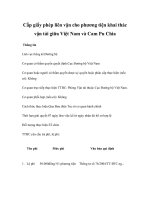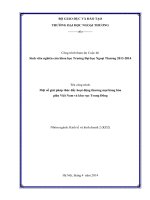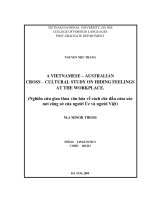Giao thoa văn hóa giữa Việt Nam và Anh
Bạn đang xem bản rút gọn của tài liệu. Xem và tải ngay bản đầy đủ của tài liệu tại đây (110.51 KB, 10 trang )
HUE UNIVERSITY COLLEGES OF FOREIGN LANGUEGES
ENGLISH DEPATERMENT
…..….
CROSS - CULTURE
TOPIC: THE USE OF NONVERBAL COMMUNICATION IN
CLASSROOM
Course instructor: Nguyen Thi Thanh Binh
Full name
: Ho Dang Thu Huyen
Student code
: 15F7511148
Group
:7
HUE, 5/2018
Contents
I. Introduction....................................................................................................................3
II. What is Nonverbal communication?..............................................................................3
III. Why nonverbal communication is important in the classroom.....................................5
IV. Influences of cultural on nonverbal communication in the classroom..........................5
V. Some differences in the nonverbal communication between Vietnamese students and
other countries students in the classroom...........................................................................7
1. Eye contact..................................................................................................................... 7
2. Facial expression............................................................................................................7
3. Gesture........................................................................................................................... 8
4. Posture........................................................................................................................... 8
VI. Conclusion...................................................................................................................9
REFERENCES..................................................................................................................10
I. Introduction
As we know, human beings communicate with others by exchanging information.
Usually, there are two ways of exchanging information, one is verbal communication,
and the other is nonverbal communication. Nonverbal communication has been defined
as communication without words. It includes apparent behaviors such as facial
expressions as less obvious messages such as dress, posture and spatial distance between
or more people. The importance of nonverbal communication has been proven and it is
now widely seen in numerous areas such as media, business, interpersonal relationships,
education, and politics, and so on. A lot of research and discussions on nonverbal
communication have been carried out recently; however, there is little mentioning
nonverbal communication in classrooms. Teachers often complain about discipline, lack
of attention, and many other problems of students, many of which lead to a breakdown in
communication between teacher and students or between students themselves in the
classroom. It is well known that speech is only one part of communication, yet teachers
often forget about or underestimate the importance of non-verbal communication in their
own and their students’ performance (Ledbury 2004). Normally, teachers explain lessons,
discuss ideas, or interact with students verbally. It is a pity that they rarely use positive
nonverbal communication in front of students. It is really hard to find a smile on their
face, or a glint of amusement in their eyes when they receive the best try from students
(classroom observations). That is to say, they are quite unmindful of using nonverbal
communication in classrooms, which often results in discouraging students to participate
in classroom activities. Many teachers do not pay enough attention to nonverbal
communication in class, contributing directly to failure in achieving teaching goals and
students’ acquisition of knowledge. However, through nonverbal communication, they
can effect personalization between class members and thus lessen the inhibitions which
normally plague students. In fact, nonverbal communication plays an important role in
our daily communication, and it is an indispensable part of in class. Therefore, with all
the thing concerned above makes me choose the topic "The use of nonverbal
communication in classroom" to do the essay.
II. What is Nonverbal communication?
The communicative behaviors of human beings can be divided into two types:
verbal communication and nonverbal communication. When it comes to the nonverbal
communication, it refers to a form of communication without using the words to express
oneself. Miller (2005) provides a rather simplistic view of nonverbal communication as
communication without words. Zoric, G & Pandzic, I. S. (2007) state that “non‐verbal
communication refers to all aspects of message exchange without the use of words” and
goes on to say that “it includes all expressive signs, signals, and cues (audio, visual,
etc.)”. Nonverbal communication includes the use of visual cues such as body language
(kinesics), distance (proxemics) and physical environments/appearance, of voice
(paralanguage) and of touch (haptics). Nonverbal communication also involves the
conscious and unconscious processes of encoding and decoding. Encoding is the act of
generating information such as facial expressions, gestures, and postures. For example is
only a small percentage of the brain processes verbal communication. Nonverbal
communication is learned well before a child begins the process of verbal communication
(Miller, 2005). The role of nonverbal actions is to assist in the communication process in
ways that simple verbalization cannot. As infants, nonverbal communication is learned
from social-emotional communication, making the face rather than voice the dominant
communication channel. As children become verbal communicators, they begin to look at
facial expressions, vocal tones, and other nonverbal elements more subconsciously.
Verbal communication only has oral form and written form. Different form verbal
communication, nonverbal communication has many forms, including gesture, touch,
body language, facial expression, eye contact and so on. According to the different
standards of classifications divided nonverbal communication into four types: body
language, paralanguage, object communication, and physical environment. Body
language refers to designation for instinctive, conscious and conventional expressive
movements of the body, including posture, head movements, facial expressions and
gesture and so on. Paralanguage, sometimes called vocalic, is the study of nonverbal cues
of the voice. It includes voice quality, emotion, and speaking style, as well as prosodic
features such as rhythm, intonation, and stress. These paralanguages may change the
meaning of the words. Nonverbal communication can be communicated by object
communication. And object communication includes clothing, hairstyle, architecture,
symbols and so on. Physical environment also has an influence on communication
behaviors. However, this environment is not research about the natural environment. It
includes furniture, architectural style, interior decorating, lighting condition, colors,
temperature, noise, and music. Also, proxemics and chromatics also are physical
environments. All physical environment factors may affect the behaviors of the
communicators during interaction.
III. Why nonverbal communication is important in the classroom:
I think that nonverbal communication is important in the classroom because of the
following reasons. Firstly, Communication is more than words, and it is important for
teachers and students to understand the nonverbal messages they are sending and
receiving in the classroom. "The telltale body is all tongues," Emerson once said, while
West famously noted, "I speak two languages, body and English." Some experts suggest
that only seven percent of a message is sent through words, with the remaining 93 percent
sent through facial expressions (55 percent) and vocal intonation (38 percent). In the
classroom, teachers and students-both consciously and unconsciously-send and receive
nonverbal cues several hundred times a day. Teachers should be aware of nonverbal
communication in the classroom for two basic reasons: to become better receivers of
students' messages and to gain awareness of the student's communication.
Secondly, nonverbal communication has implications for the teacher as well as the
students. The effective use of nonverbal cues assists in a wide range of classroom
practices by use of gesture in normal conversation, teachers can perform aspects of
classroom management quickly, quietly and efficiently. For example, gestures for 'work
in pairs','open your books', 'listen' and 'write' are universal, while individual teachers have
developed nonverbal repertoires involving the use of fingers to represent words,
expressions to denote approval/disapproval.
Finally, nonverbal messages are an essential component of communication in the
teaching and studying process. Obviously, adequate knowledge of the subject is crucial to
each teacher's success; however, it's not the only crucial element. Creating a climate of
learning and retention demands good nonverbal skills in the classroom to increases the
degree of the perceived psychological closeness between teacher and student, allow
teachers to be better receivers of students' messages and to reinforce learning.
IV. Influences of cultural on nonverbal communication in the classroom:
As in most cultures, non-verbal communication plays an important role in society,
sometimes to accompany and reinforce linguistic symbols, sometimes as a substitute for
words. Matsumoto (2006) notes that culture plays a significant role in molding our
nonverbal behaviors. it is imperative that we understand and recognize cultural
influences. In the process of making meaning of behavior, it is important to identify
nonverbal cues that are considered universal, versus those that carry specific cultural
meaning. For instance, the easily recognized smile is a common expression of pleasure
among all cultures. The smile, which is sometimes enigmatic to the American observer, is
another nonverbal symbol conveying the feeling of respect in Vietnamese culture. It is
used as an expression of apology for a minor offense, for example for being tardy to
class, or as an expression of embarrassment when committing an innocent blunder. For
the Vietnamese, the smile is a proper response in most situations in which verbal
expression is not needed or not appropriate. It is used as a substitute for “I’m sorry”,
“Thank you” or “Hi!” It is used instead of a ready yes to avoid appearing overenthusiastic.
While some nonverbal cues may have universal meaning, the ease with which they
are exhibited is also a cultural variable such as the facial expressions. A Vietnamese
student who sits quietly and listens attentively to the teacher wants to express respect to
his teacher. This behavior has often been misinterpreted by the American teacher as
passivity and non-responsiveness. It is also out of respect that the Vietnamese student
avoids eye contact with the teacher when speaking or being spoken to. By American
standards, a person acting in this way would appear suspicious, unreliable, or
mischievous. In Vietnamese culture, however, looking into somebody’s eyes, especially
when this person is of a higher status (in age or in social or family hierarchy) or of a
different gender, usually means a challenge or an expression of deep passion. The proper
respectful behavior is to avoid eye contact in talking who is not an equal or the same sex.
Moreover, the personality characteristic of people in countries which have an
influence on nonverbal communication. As Duong, Diller, and Sutherland (1975) state
that “According to Vietnamese custom, one should remain modest and humble, showing
the extent of knowledge or skills only when asked. In Vietnam, there is the motto of
saying less than what one actually knows, often an admirable characteristic. Modesty and
humility for Vietnamese are very important social graces, and deeply ingrained into their
identity”. Vietnamese students are often the hesitation and shyness. They are rather quiet
in class and seldom volunteer to express their ideas or to contribute to the lesson, let
alone asking the question to the teachers. It leads to “one way question” all the time in
class. In other words, only teachers give out the question and students just wait for the
answer. And when they are asked to make questions, their response questions usually
carry practicing characteristic.
V. Some differences in the nonverbal communication between Vietnamese students
and other countries students in the classroom:
1. Eye contact
Normally, eye contact is a form of nonverbal communication and eye contact occurs
when people look directly into each other’s eyes while talking. Since the visual sense is
dominant for most people, eye contact is an especially important type of nonverbal
communication. The way we look at someone can communicate many things, including
interest, affection, hostility or attraction. The eyes are said to be the window to the soul,
so “the cheapest, most effective way to connect with people is to look them into the eye”
(Nicholas Boothman). However, there are differences among different cultures in the way
they evaluate the importance of eye contact in communication. In the classroom of
Vietnam, when students present the presentation, they often avoid eye contact with the
audiences or teacher when they talk. Because Vietnamese students are hesitation and
shyness or even they are not confident and they don’t care about the audiences. So it is
too difficult for the Vietnamese students to have a successful presentation. Whereas, some
countries such as America, Hungary, and southern Europe, looking people in the eyes is
assumed to indicate honesty and straightforwardness. If we communicate without eye
contact, people can understand that you are not interested in them, even you are not
truthful. Unlike Vietnamese students, when students from Western countries present a
presentation, eye contact is maintained during the presentation. If they look at the
audiences’eyes a lot when they talk, the audiences will think that the presenters are pen,
friendly, confident, and natural and it also means that the audiences can involve them in
your presentation easily.
2. Facial expression
The human face is extremely expressive, able to express countless emotions
without saying a word. It can’t be denied that facial expression is mysterious. Unlike
some other forms of nonverbal communication, facial expressions are universal. The
facial expressions of happiness, sadness, anger, and disgust are the same across cultures.
However, the different cultures also construct their own rules for what are appropriate
facial expressions. For example, smiling facial expressions have many different
significant. For Vietnamese students, they smile because they do not know how to reply
to a hard question from their teacher. Simply, they smile to express their emotions or they
smile because they satisfied with their current environment.
3. Gesture
The gesture also plays an important role in communication. However, the meaning of
gestures can be very different across cultures, so it is necessary to be careful to avoid
misinterpretation. For example, in most countries, shaking head side to side means
disagree, but in India it has opposite meaning. In English-speaking countries, beckoning
people to come with palm up is very common, however, the same gesture in Vietnam, as
well as other Asian countries, is considered rude, because it is used to beckon an animal.
The use of gestures and hand signals help students express themselves and clarify verbal
questions or responses. Steepling, which is either the process of interlocking one’s
fingers or merely placing the fingertips of opposing hands together, is a demonstration of
confidence.
4. Posture
Posture plays a significant role in exchanging meanings because people tend to
remember better what they see than what they hear. The images always make a deep
impression on human brains; especially it is the image of the person who is giving
information to a group of people. In Vietnam, when speaking to a teacher, posture is very
important. Slouching and sitting while crossing the legs is not acceptable, while hands in
pockets or clasped behind the back is impolite. In addition, putting the feet up on a table
or chair is shows that they do not care about what the teacher is saying and is
disrespectful. Also, a cap should not be worn, and students need to pay attention to the
dress code such as no tank tops or short shorts. Teachers should be treated in the same
polite way whether inside or outside of class, and they should be referred to 'thầy' (male
teacher) or 'cô' (female teacher). Even if the student is older than the teacher, they would
still have to use the proper terms of address, but can use the informal way of saying I, 'tôi’
instead of referring to one’s self as “em”, also known as “younger sibling”. When the
entrance and exit of a teacher in a classroom is made, all students must stand up and
slightly bow. Opposing a teacher’s thoughts and opinions or lectures is not as open and
accepted in Vietnam, as suppose to the United States. Different from Vietnam, the
relationship between teachers and students in American schools is equal and friendly.
Students communicate with their teachers freely. Teachers receive and evaluate students'
opinions without any personal attitude.
VI. Conclusion:
To sum up, nonverbal communication is a universal and well‐defined form of
interaction. When the cultures crossed, nonverbal communication is essential for all of us
to become more sensitive, more aware, and more observant to the myriad emotions,
gestures, and body language that surround us each day. Sometimes, such differences on
culture are not easy to realize immediately which leads to misunderstanding.
Consequently, these differences can reduce the effectiveness of learning and teaching
activity. In reality, nonverbal communication can improve teaching effectiveness and help
for students in learning process. The teacher can use nonverbal communication to teach
more vivid and visualization. Therefore, both students and teachers should know
distinctive features of nonverbal communication to help themselves overcome cultural
barriers in learning and teaching process to achieve the best effective.
REFERENCES:
1. Ledbury, R. (2004), The Importance of Eye Contact in the Classroom, The
Internet TESL Journal, VOL. X, No. 8.
2. Miller, P. W. (2005), Body language in the classroom, Techniques.
3. Zoric, G & Pandzic, I. S. (2007), Facial Gestures: Taxonomy and applications of
non‐verbal, non‐emotional facial displays for embodied conversation agents, In T.
Nishida (Ed.), Conversational Informatics: An Engineering Approach. West
Sussex: John Wiley & Sons Ltd.
4. Matsumoto, D. (2006), Culture and nonverbal behavior, The SAGE Handbook of
Nonverbal Communicatio.
5. Duong, B. T. & Diller, A-M. & Sutherland, K. (1975), A handbook for teacher of
Vietnamese students: Hints for dealing with cultural differences in schools, US:
Center for applied Linguistics.
6. Unisquehanoi, Deep cultural,
/>7. Vietnam Culture, Vietnamese Non-verbal Communication, />8. The progressive Teacher (2007), Effective Body Language In The Classroom,
/>









